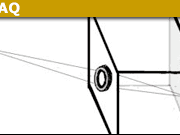Learn About New High Performance Ultra-wide Angle Camera Lenses
Note, unless otherwise specified, all focal lengths are in terms of the 35mm image format.
Recently, there has been a flurry of new high-performance ultra-wide-angle lenses introduced to the consumer market. The imaging properties of these lenses are very different from other photographic lenses; the techniques used with these lenses are also very different. Because they have not been easily available for very long, many people have not had a chance to use them, so I thought an ‘update’ about this type of lens may be of value. There are many online guides explaining how to compose a photograph using an ultrawide, for example:
https://digital-photography-school.com/how-to-get-the-best-results-from-ultra-wide-lenses/
These lenses have fields of view significantly wider than your natural vision, which for each eye is about 55 degrees, roughly equivalent to a 45mm focal length lens. Until fairly recently (around 2005), high-performance camera lenses with focal lengths shorter than 18mm were generally difficult to find. Today, interchangeable camera users have access to many ‘rectilinear’ lenses with fields of view exceeding 110 degrees.
The distinction between wide-angle and ultrawide angle is fuzzy, but a good rule of thumb is that if the lens focal length is shorter than the short side of the sensor (24mm for 35mm format), the lens is called ‘ultrawide’. ‘Fisheye’ lenses have fields of view up to and exceeding a full hemisphere. The primary distinction between a fisheye and an ultrawide is that an ultrawide lens is designed to minimize distortion, while the fisheye (including design variants such as orthographic projection lenses and f-theta lenses) is designed to incorporate significant amounts of distortion. In images acquired with an ultrawide lens, straight lines (ideally) stay straight- ultrawide are ‘rectilinear’ lenses.
The shortest focal length currently available (2017) is a 10mm “hyper wide” lens sporting a field of view of 130 degrees. Several companies provide 11mm focal length lenses, others offer 12mm, and 14mm/15mm lenses are now fairly commonplace. There are even several ultrawide zoom lenses and an ultrawide tilt-shift lens. To give you a sense of how the field of view varies with focal length, see this image:

While not indicated, a 50mm lens would only see the central group of 2 bookshelves and staircase.
Historically, wide-angle lens design began in 1862 and (in my opinion) reached a zenith with the Hypergon and Metrogon/Topogon lenses.
https://www.cameraquest.com/hyper.htm
http://camera-wiki.org/wiki/Metrogon
Note, however, that these lenses were designed for large-format film. Ultrawide angle lenses have several design issues unique to short focal lengths including falloff, flare, fabrication, filters, and (f)chromatic (f)aberrations.
Many design constraints for ultrawide are principally driven by the relatively large distance between the lens mounting flange and the sensor. On most cameras, this distance is longer than the lens’s back focal length, and the general lens design is known as a ‘retro focus design, sort of the opposite of a telephoto lens design. Lenses placed closer to the image plane, in general, are easier to design and fabricate. Because of this, wide-angle lenses were developed for rangefinder cameras (and can be used on mirrorless cameras) well before SLR cameras. Rangefinder camera users had several choices for many decades. However, to the best of my knowledge, the only viable SLR ultrawide for many years was Nikon’s 15mm and 13mm lenses introduced in the late 1970s and early 1980s and discontinued shortly thereafter.
While some development of APC-format ultrawide lenses occurred in the early 2000s, modern high-performance 35mm format ultrawide didn’t really appear until around 2010 when Nikon, Canon, and Zeiss each introduced new high-performance fixed and zoom ultrawide lenses. More recently, additional companies have introduced high-performance ultrawide angle lenses for full-frame 35mm cameras, with focal lengths going all the way down to 10mm (Voightlander hyper wide). There are several technical reasons why ultrawide lens design has lagged behind telephoto lenses.
One reason is the size and shape of the front element. The shorter the focal length, the more strongly curved the front element must be similar to the fisheye lens design. As extreme examples, Sigma’s 14/1.8 lens has an 80mm aspherical front element, while the Nikkor 13/5.6 front element measures 110mm across. These types of front lens elements are incredibly difficult to manufacture and awe-inspiring to observe.
Strongly curved front elements are one reason why ultrawide lenses can be especially susceptible to flare/glare. Lenses designed for mirrorless/rangefinder mounts have smaller diameters, as the lens is placed physically closer to the sensor, which helps to reduce flare.
A second technical difficulty is correcting transverse chromatic aberration due to the dispersion of those large, highly curved, lens elements. In general, the designs of all of these new lenses were enabled by the introduction of new types of optical glass (extra-low dispersion and anomalous partial dispersion glass types) by the major foundries.
Falloff, the optical throughput as a function of image height, occurs because the entrance pupil, the projection of the aperture stop into object space, does not remain constant as the location in object space moves off the optical axis: at more oblique incident angles, the round hole appears as an elliptical hole. Correcting for falloff becomes more difficult as the field of view increases. Two non-optical approaches include a ‘star fan’ some Hypergons came supplied with, and center filters.
One potential problem unique to digital sensors is caused by the Bayer filter: ultrawide lenses generate rays that enter the sensor at extreme angles due to the large field of view. The Bayer filters may not perform the same way as it does for rays that enter at more moderate angles. As a result, there can be chromatic effects around the periphery of the image independent of any uncorrected transverse color aberration.
Similarly, the huge front element generally makes the use of filters difficult or not possible. Aside from the increased size of the filter, there often is no place for a filter in front of the lens- some 3rd party filter makers (Coker, etc) have developed contraptions allowing the use of large square filters, and the old Nikkors have slot in the rear of the lens. Using polarizers will create a strong effect in the sky (whether this is good or bad depends on your point of view). Again, the smaller diameter lenses associated with rangefinder/mirrorless have more filter options.
What’s new for SLR users is also true for other camera mounts: for C-mount cameras, for example, there are now 1.3mm focal length lenses with 135-degree field of view which are equivalent to the 10mm hyper wide.
How low can the designers go? It’s unclear because I’m not sure how the front element scales with the focal length. Seeing how large the Nikkor 6mm/2.8 and Coastal Optics (Jenoptik) 7.45mm/2.8 front elements are gives some idea- just note that those are fisheye lenses, so the front element is quite a bit smaller than what would be required for a rectilinear lens of similar focal length. For comparison, the large format 60mm Hypergon has a 135-degree field of view, scaling this to a 35mm format gives a 7mm equivalent focal length- the 10mm hyperwide approaches the 60mm Hypergon in field of view but provides improved throughput.
In summary, the recent explosion of high-performance ultrawide lenses provides photographers with a hugely expanded range of choices at the ‘other’ end of focal length.
PhD Physics – Associate Professor
Department of Physics, Cleveland State University








Funny thing. I was very chuffed with how well my Pentax 14mm lens performed but, on the other hand, I was disappointed that the pictures don't 'look' wide angle. It's almost as if I need to give them a digital nudge to get that wide angle effect. It's just the same as people who claim to like vinyl records. I guess.
BTW, good article, @Andy Resnick.
Given that lens distortion can now be removed digitally, I wonder if it is better to do that then to use extra glass to make likes straight optically?
I take it this article is only about cameras with 35 mm size sensors? Lenses with 180° already exist on devices that pair two of them to image 360° video.
http://www.bestbuy.com/site/ricoh-t…ffcode=pg174715&ksdevice=c&lsft=ref:212,loc:2I didn't mean to implicitly discuss only 35mm-sized sensors; there are ultra-wide lenses for medium and large format sizes as well (the Super Angulon and Grandagon series of lenses, for example).
The Theta S and similar cameras (KeyMission 360, for example) use multiple sensors, and I also distinguished between fisheye lenses that have large distortion from rectilinear lenses, which do not. I focused on the development of new rectilinear ultrawide lenses.
The shortest focal length currently available (2017) is a 10mm “hyperwide” lens sporting a field of view of 130 degrees.
Reference https://www.physicsforums.com/insights/new-high-performance-ultra-wide-angle-lenses/I take it this article is only about cameras with 35 mm size sensors? Lenses with 180° already exist on devices that pair two of them to image 360° video.
http://www.bestbuy.com/site/ricoh-t…ffcode=pg174715&ksdevice=c&lsft=ref:212,loc:2
Andy, curious if you have ideas on where lens technology goes from here?Good question- although predicting the future is a fool's errand :) In general the trend is to larger apertures, reduced size/weight, decreased chromatic aberrations, and improved accutance. All of this is contingent on developments in optical materials- mainly glass- and the ability to grind aspheres. Incorporation of image stabilization is increasing as well. These developments all fall under "improved performance of existing lens designs".
Something more 'exotic' I'm interested in is 3-D PSF engineering. That is, rather than simply design improved performance in the focal plane, the entire PSF can be designed- at least that's what is claimed for the new Nikkor 58/1.4. It's an interesting idea.
Andy Resnick submitted a new PF Insights postnice write-up, Andy, thanks :)
my goto UW angle lens is my Samyang 14mm, f2.8
View attachment 114964
I have been quite pleased with it's quality considering its affordable ~ AU$360 price tag
particularly on wide angle astrophotography where pinpoint light sources from stars gives a good test
Andy, curious if you have ideas on where lens technology goes from here?